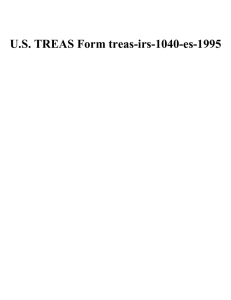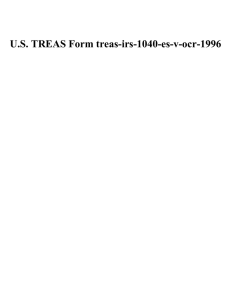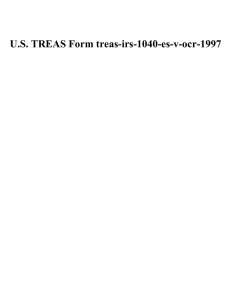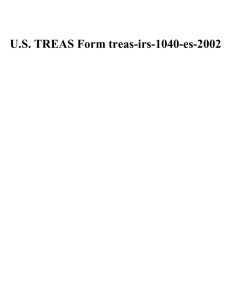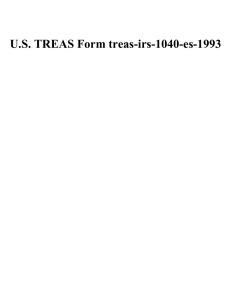U.S. TREAS Form treas-irs-1040-es-1997
advertisement
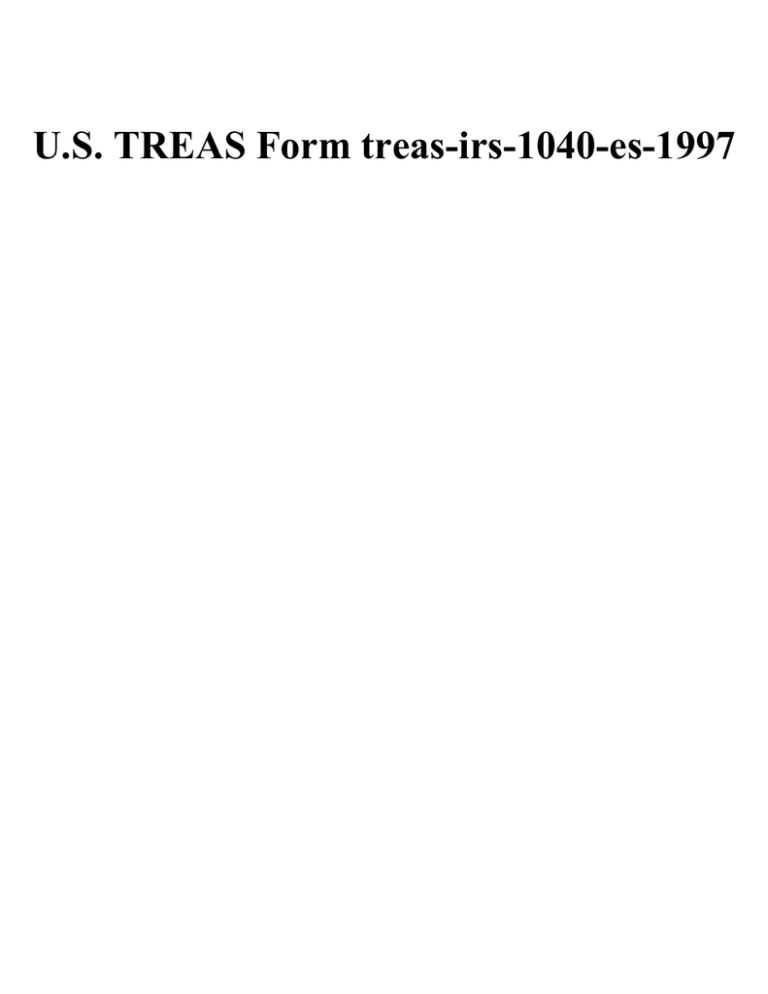
U.S. TREAS Form treas-irs-1040-es-1997 Form 1040-ES Department of the Treasury Internal Revenue Service Estimated Tax for Individuals This package is primarily for first-time filers of estimated tax. Paperwork Reduction Act Notice We ask for the information on the payment vouchers to carry out the Internal Revenue laws of the United States. You are required to give us the information. We need it to ensure that you are complying with these laws and to allow us to figure and collect the right amount of tax. You are not required to provide the information requested on a form that is subject to the Paperwork Reduction Act unless the form displays a valid OMB control number. Books or records relating to a form or its instructions must be retained as long as their contents may become material in the administration of any Internal Revenue law. Generally, tax returns and return information are confidential, as required by Internal Revenue Code section 6103. The time needed to complete the worksheets and prepare and file the payment vouchers will vary depending on individual circumstances. The estimated average time is: Recordkeeping, 1 hr., 19 min.; Learning about the law, 18 min.; Preparing the worksheets and payment vouchers, 49 min.; Copying, assembling, and sending the payment voucher to the IRS, 10 min. If you have comments concerning the accuracy of these time estimates or suggestions for making this package simpler, we would be happy to hear from you. You can write to the Tax Forms Committee, Western Area Distribution Center, Rancho Cordova, CA 95743-0001. DO NOT send the payment vouchers to this address. Instead, see Where To File Your Payment Voucher on page 5. OMB No. 1545-0087 97 However, if you did not file a 1996 tax return or that return did not cover all 12 months, item 2 above does not apply. For this purpose, household employment taxes are not included when figuring the tax shown on your tax return and are not required to be included when figuring your estimated tax payments. However, you may choose to include these taxes when paying estimated tax to avoid a large balance due at the time your tax return is due. Exception. You do not have to pay estimated tax if you were a U.S. citizen or resident alien for all of 1996 and you had no tax liability for the full 12-month 1996 tax year. The estimated tax rules apply to: ● U.S. citizens and residents, ● Residents of Puerto Rico, the Virgin Islands, Guam, the Commonwealth of the Northern Mariana Islands, and American Samoa, and ● Nonresident aliens (use Form 1040-ES (NR)). If you also receive salaries and wages, you may be able to avoid having to make estimated tax payments by asking your employer to take more tax out of your earnings. To do this, file a new Form W-4, Employee’s Withholding Allowance Certificate, with your employer. Caution: You may not make joint estimated tax payments if you or your spouse is a nonresident alien, you are separated under a decree of divorce or separate maintenance, or you and your spouse have different tax years. Additional Information You May Need Purpose of This Package Use this package to figure and pay your estimated tax. Estimated tax is the method used to pay tax on income that is not subject to withholding; for example, earnings from self-employment, interest, dividends, rents, alimony, etc. In addition, if you do not elect voluntary withholding, you should make estimated tax payments on unemployment compensation and the taxable part of your social security benefits. See the 1996 instructions for your tax return for more details on income that is taxable. This package is primarily for first-time filers who are or may be subject to paying estimated tax. This package can also be used if you did not receive or have lost your preprinted 1040-ES package. The estimated tax worksheet on page 4 will help you figure the correct amount to pay. The payment vouchers in this package are for crediting your estimated tax payments to your account correctly. Use the Record of Estimated Tax Payments on page 5 to keep track of the payments you have made and the number and amount of your remaining payments. After we receive your first payment voucher from this package, we will mail you a 1040-ES package with your name, address, and social security number preprinted on each payment voucher. Use the preprinted vouchers to make your remaining estimated tax payments for the year. This will speed processing, reduce processing costs, and reduce the chance of errors. Do not use the vouchers in this package to notify the IRS of a change of address. If you have a new address, order Form 8822, Change of Address, by calling 1-800-TAX-FORM (1-800-829-3676). Send the completed form to the Internal Revenue Service Center where you filed your last tax return. The Service Center will update your record and send you new preprinted payment vouchers. Note: Continue to use your old preprinted payment vouchers to make payments of estimated tax until you receive the new vouchers. Who Must Make Estimated Tax Payments In most cases, you must make estimated tax payments if you expect to owe, after subtracting your withholding and credits, at least $500 in tax for 1997, and you expect your withholding and credits to be less than the smaller of: 1. 90% of the tax shown on your 1997 tax return, or 2. The tax shown on your 1996 tax return (110% of that amount if you are not a farmer or a fisherman and the adjusted gross income shown on that return is more than $150,000 or, if married filing separately for 1997, more than $75,000). Most of the information you will need can be found in: Pub. 505, Tax Withholding and Estimated Tax. Other available information: Pub. 553, Highlights of 1996 Tax Changes, and Instructions for the 1996 Form 1040 or 1040A. To order forms and publications, call 1-800-TAX-FORM (1-800-829-3676). If you have a personal computer and a modem, you can also get forms and publications electronically. For details, see page 5 of the Instructions for Form 1040 or page 5 of the Instructions for Form 1040A. If you have tax questions, call 1-800-829-1040 for assistance. Tax Law Changes Effective for 1997 Use your 1996 tax return as a guide in figuring your 1997 estimated tax, but be sure to consider the changes noted in this section. For more information on changes that may affect your 1997 estimated tax, see Pub. 553. Voluntary Withholding on Social Security and Other Federal Payments. Beginning in 1997, you can choose to have Federal income tax withheld on social security benefits; tier 1 railroad retirement benefits; unemployment compensation; certain crop disaster payments; and Commodity Credit Corporation loans. To make this choice, see Form W-4V, Voluntary Withholding Request. Increase in IRA Deduction for Certain Spouses. For tax years beginning after 1996, the limit on the maximum IRA deduction for a married couple filing a joint return has increased for the spouse with the smaller compensation. The deduction limit for the spouse with the smaller compensation is equal to the smaller of (a) $2,000, or (b) the compensation of both spouses reduced by the amount of the IRA deduction claimed by the other spouse. As a result of this change, the limit on nondeductible contributions to IRAs also has increased. Section 179 Expense Deduction Increased. For 1997, the deduction to expense certain property under section 179 generally has been increased to $18,000. (Continued on page 2) Cat. No. 11340T
